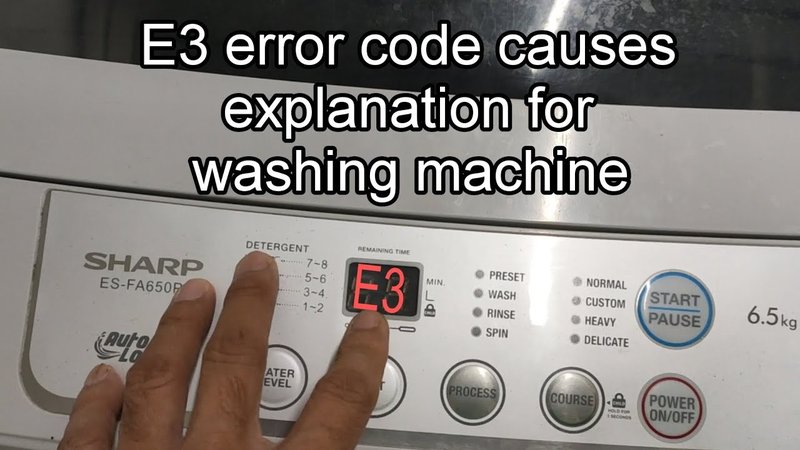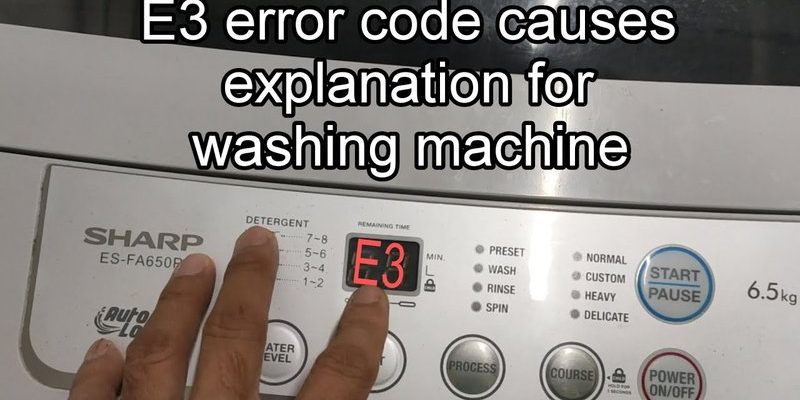
Imagine this: It’s like when you’re trying to balance a stack of books on your head. If the books are stacked unevenly, you might find yourself wobbling a bit, right? Similarly, your washing machine tries to balance the load within the drum to ensure a smooth spin cycle, and if it can’t, it throws out that E3 error as a cry for help. It’s like your washing machine saying, “Hey, something’s not quite right here!” But don’t worry just yet; not all error codes mean the end of the world—or your wash cycle!
Understanding the GE Washing Machine E3 Error Code
So, what exactly causes this E3 error code to appear? The main culprit is often an unbalanced load. If you’ve ever tossed a handful of jeans in with just a single shirt, you’re familiar with how lopsided a load can become. In washing machine terms, that’s like trying to tiptoe across a tightrope with one shoe on and one foot bare. The washing machine senses this imbalance and sends out the E3 error to alert you that things aren’t quite right.
Another possible cause could be the washing machine’s inability to detect the load weight properly. This usually happens when the load sensor, which is like the washing machine’s internal scale, doesn’t get the right reading due to mechanical or calibration issues. If the sensor wrongly detects the load as heavier or lighter than it actually is, it might send mixed signals, leading to this error code. It’s like when a bathroom scale gives you a reading that makes you think, “No way, that’s not right!”
Finally, there might be a technical issue with the motor or the drive system of the machine, which could be a bit trickier to resolve without professional help. If the motor can’t handle the load due to wear and tear or some internal glitch, that’s when you’d see the E3 error. If you’ve ever tried to push a car up a hill, you know how demanding it can be on the engine—and the human pushing it!
When to Try Fixing the E3 Error Code Yourself
Before you reach for the phone to call a technician, there are a few things you can try at home. Start by checking how the clothes are loaded. If they’re all bunched up on one side, redistribute them evenly around the drum. It’s like leveling out a seesaw by spreading out the weight so it balances perfectly. If that doesn’t solve the problem, try removing some items and running a smaller load to see if that helps.
Another simple fix could be to reset your machine. Most GE washing machines have a reset function—consult your manual to find out how to do this for your specific model. Think of it as the good old “turn it off and back on again” trick that works wonders for computers and electronics alike.
If you’ve tried rebalancing the load and resetting the machine to no avail, double-check to see if any foreign objects, like coins or buttons, are lodged in the drum. They can sometimes cause disruptions in the machine’s functioning, leading it to throw up an E3 error. You know that feeling when a pebble gets stuck in your shoe? Clearing it out can make a world of difference.
When It’s Time to Call a Technician
So, when should you definitely consider calling a professional technician? If you’ve tried all the above and the error persists, it is time for expert help. The issue might be with the internal components like the motor, the drive belt, or the load sensor, which require technical skills and tools to diagnose and fix. Attempting a DIY fix in such scenarios can sometimes make things worse.
Additionally, if you hear unusual noises, like grinding or screeching, it’s best to halt any further use of the washer and contact a professional. It’s like when your car starts making that funny noise, and you know that ignoring it would just lead to more trouble down the road. A technician can open up the machine safely, ascertain the problem, and provide a solution that ensures your washing machine is back to its best self.
Lastly, if your washing machine is under warranty, it’s wise to call the manufacturer’s support line first. They might offer a free repair or technician visit, saving you some money. Plus, they would have a list of approved technicians who are experienced in dealing with GE appliances specifically.
Preventing the E3 Error Code
The best way to avoid the E3 error code—and many other issues—is by taking care of your washing machine. Load it sensibly, using the right amount of clothes, and refer to your manual for the optimal load size. It’s like packing a suitcase; you need to balance it right to prevent it from tipping over.
Also, consider performing regular maintenance checks. Cleaning the drum, filters, and detergent dispensers can prevent build-up that might alter the machine’s efficiency. It’s like keeping your workspace tidy so you can always find things where they’re supposed to be.
Finally, make it a habit to do lighter loads if you can, as constantly overloading the washing machine can wear down its parts faster. Treat your washing machine kindly, and it will likely return the favor, running smoothly for years to come.
By following these guidelines, you’re likely to reduce the chances of running into the E3 error code again. And if it does pop up, you’ll know exactly what to do—or who to call!
